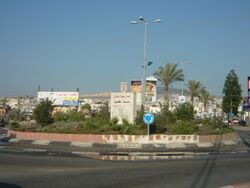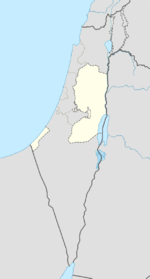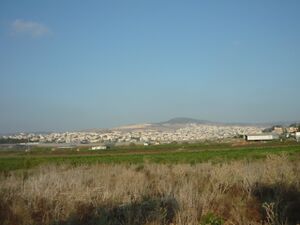طمرة
طمرة
| |
|---|---|
City (from 1996) | |
| الترجمة اللفظية بالـ العبرية | |
| • ISO 259 | Ṭámra, Támra |
 View of Tamra | |
| الإحداثيات: 32°51′13″N 35°11′52″E / 32.85361°N 35.19778°E | |
| Grid position | 169/250 PAL |
| District | Northern |
| الحكومة | |
| • Mayor | Sohil Diab |
| المساحة | |
| • الإجمالي | 29٬259 dunams (29٫259 كم² or 11٫297 ميل²) |
| التعداد | |
| • الإجمالي | قالب:Palestine populations |
| Name meaning | from make a pit for storing corn[1] |
طمرة هي قرية عربية تقع في الجليل الغربي من فلسطين داخل الخط الأخضر تبعد مسافة 18 كم عن مدينة عكا و 30 كم عن مدينة حيفا، يبلغ عدد سكان المدينه نحو 30,000 نسمه 2008، جميع سكان المدينة هم من المسلمين، كانت طمره قرية حتى سنة 1995 عندما حصلت على لقب مدينة. في طمرة هنالك 9 مدارس ابتدائية، وثلاث اعداديات، وثانويتين، ومدرسة صناعية والعديد من مراكز التعليم الأخرى ومراكز الشبيبة. هناك أيضاً مركزاً للطلاب الموهوبين والمتفوقين في طمرة يستقبل الطلاب من طمرة - كابول - كفر ياسيف - الجديدة والمكر الشيخ دنون المزرعة وعكا.
يوجد في المدينه 9 مساجد وهم حسب الأقدميه:
- المسجد القديم.
- مسجد القبه.
- مسجد السلام.
- مسجد الدعوه.
- مسجد خلة الشريف.
- مسجد بلال بن رباح (العين).
- مسجد الرحمه.
- مسجد معاذ بن جبل
- مسجد التابعين (خلة الغزال).
التاريخ
طمرة هي قرية قديمة على أحد التلال، وقد أعيد استخدام الكتل الحجرية المربعة القديمة في بناء منازل القرى. تم اكتشاف خزانات أرضية ومقابر محفورة في الصخور في طمرة.[2]
في عام 1253، وخلال حقبة الحملات الصليبية، باع جون ألمان سيد قيسارية العديد من القرى، ومنها طمرة إلى فرسان الإسبتارية.[3] في 1283، ذكر أنها كانت جزءا من الأراضي الواقعة تحت سلطة الصلبيين حسب الهدنة التي وقعها السلطان المملوكي قلاوون في عكا.[4]
الحقبة العثمانية
أصبحت طمرة تابعة إلى الأمبراطورية العثمانية عام 1517 وحسب تعداد عام 1596 فكانت القريبة تتبع ناحية عكا، وجزءا من سنجق صفد. كان تعدادا الأسر المسلمة في هذا الوقت 22 أسرة، وكانوا يدفعون ضرائب بنسبة 20% على القمح، والشعير، والأشجار المثمرة، والقطن، والعائدات العرضية، والنحل، والمراعي الشتوية؛ أي أن المجموع 2,929 آقجة.[5][6] في 1799 جاء اسم طمرات في خريطة پير جاكوتين.[7]
عام 1859، قدّر القنصل البريطاني (روجرز) عدد السكان ب 1,200 نسمة جمبعهم من المسلمين، وعدد الأراضي الزراعية ب 80 فدان،[8] فحين أن فيكتور گويرين وجد أن عدد سكانها عام 1875 يبلغ 800 نسمة وجميعهم من المسلمين.[9]
في عام 1881، وصف طمرة المسح الجغرافي لغرب فلسطين الذي قام به صندوق استكشاف فلسطين بأنها: قرية كبيرة، بها مسجد صغير على الجانب الشرقي، وطاحونة في الجزء الشمالي. وهناك مقابر محفورة في الصخر غرب المنازل. أما في جنوب القرية، في الوادي، وتمتد بستاتين الزيتون حتى الرويس."[8]
تظهر لائحة سكانية تعود لعام 1887 تقريبًا عدد سكات طمرة في هذا الوقت، 535 نسمة من المسلمين.[10]
فترة الانتداب البريطاني
At the time of the 1922 census of Palestine Tamra had a population of 1,111, all Muslims,[11] increasing in the 1931 census to 1,258, all Muslims, in a total of 282 houses.[12]
In the 1945 statistics, Tamra had 1,830 inhabitants, all Muslims,[13] while the total jurisdiction of the village was 30,559 dunams of land.[13][14] 1,564 dunams were used for plantations and irrigable land, 14,434 dunams for cereals,[13][15] while 206 dunams were built-up (urban) land.[13][16]
دولة إسرائيل
Tamra was captured by Israeli forces from the Arab Liberation Army and the Syrian Army in 1948 Arab–Israeli War as a part of Operation Dekel. On 20 May 1948 the civilian population had been evacuated on orders from Arab irregular forces. According to Benny Morris it was feared that the village would surrender to the Yishuv.[17] The city grew rapidly in the period of Israel's first years as a nation due to the influx of Palestinian refugees from destroyed nearby villages such as al-Birwa or al-Damun. Large percentages of the city's farming land was expropriated by Israeli authorities and allocated to farming cooperatives and nearby Jewish settlement towns such as Mitzpe Aviv. Tamra achieved local council status in 1956 and was declared a city in 1996.
The city became famous for its large dairy factory named "Rajeb-Tamra", taking a certain portion of the dairy market in Israel, especially in the Arab sector.
الديمغرافيا
According to the Israel Central Bureau of Statistics (CBS), at the end of 2007 the city had a total population of 27,300.[18] In 2001, the ethnic makeup of the city was almost entirely Arab (99.6% Muslim), with no significant Jewish population. See Population groups in Israel.
According to CBS, in 2001 there were 11,900 males and 11,400 females. The population of the city was spread out, with 48.5% 19 years of age or younger, 18.0% between 20 and 29, 19.7% between 30 and 44, 9.0% from 45 to 59, 1.6% from 60 to 64, and 3.0% 65 years of age or older. The population growth rate in 2001 was 3.3% and 2005 had dropped to 2.5%.[19]
The largest and most influential clan in Tamra is the Diab, which consists of several branches.[20] Other clans include the Hejazi, and the smaller clans of Abd al-Hadi, Abu Na'ama, Abu Rumi, Amar, Arshid, Awwad, Kanaan, Muhsin, Nasser, Natour, Ourabi, Radi, Shama, Shaqir, Sheikh Ali and Yassin.[21] In addition to the aforementioned clans, whose presence in Tamra predates the state of Israel, the city is home to internally displaced Palestinians and their descendants from the nearby villages of al-Damun, Hadatha, Mi'ar and al-Ruways, which were depopulated during the 1948 Arab-Israeli war.[22]
الدخل
According to CBS, as of 2000, in the city there were 3,908 salaried workers and 375 are self-employed. The mean monthly wage in 2000 for a salaried worker in the city is ILS 2,887, a real change of −2.2% over the course of 2000. Salaried males have a mean monthly wage of ILS 3,358 (no real change) versus ILS 1,977 for females (a real change of −7.6%). The mean income for the self-employed is 4,763. There are 445 people who receive unemployment benefits and 5,290 people who receive an income guarantee.
التعليم
According to CBS, there are 13 schools and 5,779 students in the city. They are spread out as 9 elementary schools and 4000 elementary school students, and 3 high schools and 2,324 high school students. 54.6% of 12th grade students were entitled to a matriculation certificate in 2001.
During the late 1990s sociologist As'ad Ghanem set up an NGO in Tamra. It was called Ibn Khaldun and campaigned for more Arab history to be taught in Israeli schools.[23]
الرياضة
The current football teams in the city are Maccabi Tamra and F.C. Tzeirei Tamra, both play in Liga Gimel, the fifth tier of Israeli football. Maccabi Tamra and Hapoel Bnei Tamra (which is now defunct), played in the past in Liga Artzit, having been promoted from Liga Alef in 1988 and 2006 respectively.
Notable residents
- Mohammed Awaed (born 1997), football player for Maccabi Haifa
- Yussef Diab (1917–1984), Member of the Knesset
انظر أيضاً
الهامش
- ^ Palmer, 1881, p. 117
- ^ Dauphin, 1998, p. 664
- ^ Delaville Le Roulx, 1883, p. 184; cited in Clermont-Ganneau, 1888, pp. 309 -310; cited in Röhricht, 1893, RRH, p. 319, No. 1210
- ^ al-Qalqashandi version of the hudna, referred in Barag, 1979, p. 204, no. 20
- ^ Hütteroth and Abdulfattah, 1977, p. 192
- ^ Note that Rhode, 1979, p. 6 writes that the Safad register that Hütteroth and Abdulfattah studied was not from 1595/6, but from 1548/9
- ^ Karmon, 1960, p. 162
- ^ أ ب Conder and Kitchener, 1881, SWP I, p. 273
- ^ Guérin, 1880, pp. 421-422
- ^ Schumacher, 1888, p. 175
- ^ Barron, 1923, Table XI, Sub-district of Acre, p. 37
- ^ Mills, 1932, p. 103
- ^ أ ب ت ث Department of Statistics, 1945, p. 5
- ^ Government of Palestine, Department of Statistics. Village Statistics, April, 1945. Quoted in Hadawi, 1970, p. 41
- ^ Government of Palestine, Department of Statistics. Village Statistics, April, 1945. Quoted in Hadawi, 1970, p. 81
- ^ Government of Palestine, Department of Statistics. Village Statistics, April, 1945. Quoted in Hadawi, 1970, p. 131
- ^ Morris, 1987, p. 67
- ^ "Table 3 - Population of Localities Numbering Above 1,000 Residents and Other Rural Population" (PDF). Israel Central Bureau of Statistics. 2008-06-30. Retrieved 2008-10-18.
- ^ [1]
- ^ Rosenfeld and Al-Haj 1990, p. 92.
- ^ Rosenfeld and Al-Haj 1990, pp. 91–96.
- ^ Rosenfeld and Al-Haj 1990, p. 93.
- ^ Pappe, 2011, p. 219
ببليوگرافيا
- Barag, Dan (1979). "A new source concerning the ultimate borders of the Latin Kingdom of Jerusalem". Israel Exploration Journal. 29: 197–217.
- Barron, J.B., ed. (1923). Palestine: Report and General Abstracts of the Census of 1922. Government of Palestine.
- Clermont-Ganneau, C.S. (1888). Recueil d'archéologie orientale (in الفرنسية). Vol. 1. Paris.
{{cite book}}: CS1 maint: location missing publisher (link) - Conder, C.R.; Kitchener, H.H. (1881). The Survey of Western Palestine: Memoirs of the Topography, Orography, Hydrography, and Archaeology. Vol. 1. London: Committee of the Palestine Exploration Fund.
- Dauphin, Claudine (1998). La Palestine byzantine, Peuplement et Populations. BAR International Series 726 (in الفرنسية). Vol. III : Catalogue. Oxford: Archeopress. ISBN 0-860549-05-4.
- Delaville Le Roulx, Joseph (1883). Les archives, la bibliothèque et le trésor de l'Ordre de Saint-Jean de Jérusalem à Malte (in الفرنسية and اللاتينية). Paris: E. Leroux.
- Department of Statistics (1945). Village Statistics, April, 1945. Government of Palestine.
- Guérin, V. (1880). Description Géographique Historique et Archéologique de la Palestine (in الفرنسية). Vol. 3: Galilee, pt. 1. Paris: L'Imprimerie Nationale.
- Hadawi, S. (1970). Village Statistics of 1945: A Classification of Land and Area ownership in Palestine. Palestine Liberation Organization Research Center.
- Hütteroth, Wolf-Dieter; Abdulfattah, Kamal (1977). Historical Geography of Palestine, Transjordan and Southern Syria in the Late 16th Century. Erlanger Geographische Arbeiten, Sonderband 5. Erlangen, Germany: Vorstand der Fränkischen Geographischen Gesellschaft. ISBN 3-920405-41-2.
- Karmon, Y. (1960). "An Analysis of Jacotin's Map of Palestine" (PDF). Israel Exploration Journal. 10 (3, 4): 155–173, 244–253.
- Mills, E., ed. (1932). Census of Palestine 1931. Population of Villages, Towns and Administrative Areas. Jerusalem: Government of Palestine.
- Morris, B. (1987). The Birth of the Palestinian refugee problem, 1947-1949. Cambridge University Press. ISBN 0-521-33028-9.
- Palmer, E.H. (1881). The Survey of Western Palestine: Arabic and English Name Lists Collected During the Survey by Lieutenants Conder and Kitchener, R. E. Transliterated and Explained by E.H. Palmer. Committee of the Palestine Exploration Fund.
- Pappé, I. (2011). The Forgotten Palestinians. A History of the Palestinians in Israel. Yale. ISBN 978-0-300-13441-4.
- Rosenfeld, Henry; Al-Haj, Majid (1990). Arab Local Government in Israel. Westview Press. ISBN 0-8133-7761-7.
- Rhode, H. (1979). Administration and Population of the Sancak of Safed in the Sixteenth Century. Columbia University.
- Röhricht, R. (1893). (RRH) Regesta regni Hierosolymitani (MXCVII-MCCXCI) (in اللاتينية). Berlin: Libraria Academica Wageriana.
- Schumacher, G. (1888). "Population list of the Liwa of Akka". Quarterly statement - Palestine Exploration Fund. 20: 169–191.
وصلات خارجية
- Official website (in عربية)
- Welcome To Tamra
- Survey of Western Palestine, Map 5: IAA, Wikimedia commons
- Susan Nathan: An Israeli Jew in a Muslim town
- Municipality of Tamra (Israel) Flags of the World
- The Condition of the Palestinian Minority Exposed By New Book Reilly Vinall
- “ Combining Empathy with Problem Solving: The Tamra Model of Facilitation in Israel” by Eileen F. Babbitt and Pamela Pomerance Steiner, with Jabir Asaqla, Chassia Chomsky-Porat, and Shirli Kirschner, Chapter 8 of ‘ Building Peace: Practical Reflections from the Field’
- Pages using gadget WikiMiniAtlas
- Short description is different from Wikidata
- Articles containing عبرية-language text
- Articles containing explicitly cited عربية-language text
- Coordinates on Wikidata
- Pages using infobox settlement with missing country
- CS1 maint: location missing publisher
- CS1 الفرنسية-language sources (fr)
- CS1 اللاتينية-language sources (la)
- طمرة
- Arab localities in Israel
- تأسيسات 1996 في إسرائيل
- مدن المنطقة الشمالية (إسرائيل)
- بذرة فلسطين
- فلسطين


